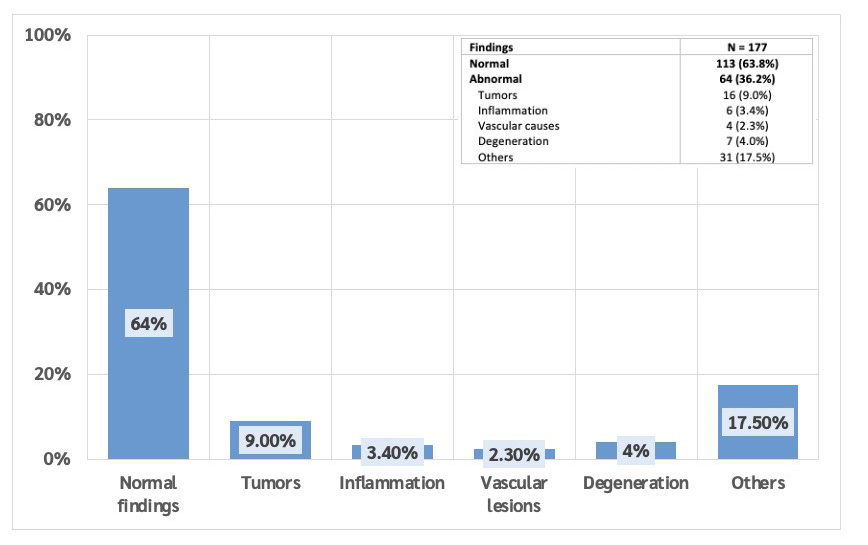Neuroimaging Findings in Acquired Esotropia Patients at Siriraj Hospital from 2009–2020
DOI:
https://doi.org/10.33192/smj.v75i7.261478Keywords:
Acquired Esotropia, NeuroimagingAbstract
Objective: To analyze the neuroimaging findings in patients with acquired esotropia at Siriraj Hospital from 2009 to 2020.
Materials and Methods: A retrospective review of the medical records of all patients aged above 6 months old who presented with acquired esotropia was done. All the patients had an angle of deviation 10 prism diopters (PD), refraction < +3.0 diopters (D), and had neuroimaging performed. The patients with restrictive myopathy and extraocular neurological abnormalities were excluded from the study.
Results: In total, 177 subjects aged between 8 months old to 81 years old (mean age 32.35 ± 24.40 years old) were included in the study. The patients’ demographic data, ocular findings, and neuroimaging findings were collected. The mean angle of deviation near and at distance were 26.88 ± 18.90 PD and 29.81 ± 17.25 PD, respectively. Of the 177 cases, 113 cases (63.8%) had no neuroimaging abnormalities, while 64 cases (36.2%) had abnormal neuroimaging findings. In those 64 cases with abnormal findings, there were 16 intracranial tumors, 6 inflammations, 4 vascular lesions, 7 degenerations, and 31 other lesions. Sixth nerve palsy was found to be significantly different between the positive and negative neuroimaging group from both the uni- and multivariate analysis.
Conclusion: Although more than half of acquired esotropia patients had no abnormalities in neuroimaging, but 14.7% of those with abnormal neuroimaging findings had underlying serious conditions, which consisted of intracranial tumors, inflammation, and vascular lesions. Special attention should be concentrated to patients with sixth nerve palsy as it was the significant factor found to be associated with positive neuroimaging findings in acquired esotropia.
References
Kaur K, Gurnani B. Esotropia. [Updated 2023 Jan 30]. In: StatPearls [Internet]. Treasure Island (FL): StatPearls Publishing; 2023.
Von Noorden GK, Campos EC. Binocular vision and ocular motility. St. Louis: Mosby, Inc; 2002.
Wright KW, Strube YNJ. Pediatric Ophthalmology and Strabismus. 3rd ed. Oxford: Oxford University Press; 2012.
Burian HM, Miller JE. Comitant convergent strabismus with acute onset. Am J Ophthalmol. 1958;45(4 Pt 2):55-64.
Hoyt CS, Good WV. Acute onset concomitant esotropia: when is it a sign of serious neurological disease? Br J Ophthalmol. 1995;79(5):498-501.
Mohan L, Meleparambath R, Shabeeba. Surge in Acute Acquired Comitant Esotropia During Covid Lockdown AIOC1. Acta Scientific Ophthalmology. 2022;5(6):13-5.
Zweifach PH. Childhood esotropia with delayed appearance of cerebellar tumour. Neuro-ophthalmology. 1981;1:291-3.
Cruysberg JR, Draaijer RW, Sellar PW. When is acute onset concomitant esotropia a sign of serious neurological disease? Br J Ophthalmol. 1996;80(4):380.
Dotan G, Rosenfeld E, Stolovitch C, Kesler A. The role of neuroimaging in the evaluation process of children with isolated sixth nerve palsy. Childs Nerv Syst. 2013;29(1):89-92.
Aroichane M, Repka MX. Outcome of sixth nerve palsy or paresis in young children. J Pediatr Ophthalmol Strabismus. 1995;32(3):152-6.
Trobe JD. Diplopia. In: Clinical decisions in neuro-ophthalmology, 3rd ed. CV Mosby, Philadelphia, 1992.p.171-2.
Brodsky MC. Ocular motor nerve palsies in children. In: Pediatric neuro-ophthalmology, 2nd ed. Springer, New York, 2010.p.281-93.
Lee MS, Galetta SL, Volpe NJ, Liu GT. Sixth nerve palsies in children. Pediatr Neurol 1999;20:49-52.
Chen J, Deng D, Sun Y, Shen T, Cao G, Yan J, et al. Acute acquired concomitant esotropia: clinical features, classification, and etiology. Medicine (Baltimore) 2015;94(51):e2273.
Cai C, Dai H, Shen Y. Clinical characteristics and surgical outcomes of acute acquired comitant esotropia. BMC Ophthalmol 2019;19(1):173.
Buch H, Vinding T. Acute acquired comitant esotropia of childhood: a classification based on 48 children. Acta Ophthalmol 2015;93(6):568-74.
Meng Y, Hu X, Huang X, Zhao Y, Ye M, Yi B, et al. Clinical characteristics and aetiology of acute acquired comitant esotropia. Clin Exp Optom 2022;105(3):293-7.
Lekskul A, Chotkajornkiat N, Wuthisiri W, Tangtammaruk P. Acute Acquired Comitant Esotropia: Etiology, Clinical Course, and Management. Clin Ophthalmol. 2021;15:1567-72.
Montriwet M. Possibility of Neurological Diseases Associated with Acute Acquired Comitant Esotropia. Korean J Ophthalmol. 2023;37(2):120-7.
Lee HJ, Kim SJ. Clinical characteristics and surgical outcomes of adults with acute acquired comitant esotropia. Jpn J Ophthalmol. 2019;63(6):483-9.
Fu T, Wang J, Levin M, Xi P, Li D, Li J. Clinical features of acute acquired comitant esotropia in the Chinese populations. Medicine (Baltimore). 2017;96(46):e8528.
Dikici K, Cicik E, Akman C, Kendiroglu G, Tolun H. Cerebellar astrocytoma presenting with acute esotropia in a 5 year-old girl: case re- port. Int Ophthalmol 1999;23:167-70.
Lee JM, Kim SH, Lee JI, Ryou JY, Kim SY. Acute comitant esotropia in a child with a cerebellar tumor. Korean J Ophthalmol 2009;23(3):228-31.
Williams AS, Hoyt CS. Acute comitant esotropia in children with brain tumors. Arch Ophthalmol. 1989;107(3):376-8.
Anderson WD, Lubow M. Astrocytoma of the corpus callosum presenting with acute comitant esotropia. Am J Ophthalmol. 1970;69(4):594-8.
Lewis AR, Kline LB, Sharpe JA. Acquired esotropia due to Arnold-Chiari I malformation. J Neuroophthalmol. 1996;16(1):49-54.
Chang MY, Borchert MS. Etiology and Outcomes of Acquired Pediatric Sixth Nerve Palsies. J Neuroophthalmol. 2022;42(1):e254-e9.

Published
How to Cite
License
Copyright (c) 2023 Siriraj Medical Journal

This work is licensed under a Creative Commons Attribution-NonCommercial-NoDerivatives 4.0 International License.
Authors who publish with this journal agree to the following conditions:
Copyright Transfer
In submitting a manuscript, the authors acknowledge that the work will become the copyrighted property of Siriraj Medical Journal upon publication.
License
Articles are licensed under a Creative Commons Attribution-NonCommercial-NoDerivatives 4.0 International License (CC BY-NC-ND 4.0). This license allows for the sharing of the work for non-commercial purposes with proper attribution to the authors and the journal. However, it does not permit modifications or the creation of derivative works.
Sharing and Access
Authors are encouraged to share their article on their personal or institutional websites and through other non-commercial platforms. Doing so can increase readership and citations.














